Karst Creek Falls is a beautiful small waterfall found on a beautiful short hike in Strathcona Provincial park. It’s not a particularly huge or impressive Vancouver Island waterfall, but it makes up for its scale in pure aesthetic quality. Located in a small gully absolutely covered in moss and surrounded by soaring trees, it’s the perfect place to just sit and breathe nature in.
The hike up Karst Creek can be done as an out-and-back, or as a loop. Frustratingly, the very end of the trail gets washed over by the creek every winter and spring, making completing the loop at these times of year challenging at best, and dangerous at worst. If you do complete the loop, I highly suggest going slowly, and appreciating the sights along the way, including a creek that appears out of the ground before disappearing again into a sinkhole.
Continue reading this blog post for everything you need to know to experience the Karst Creek Falls hike in Strathcona Provincial Park for yourself, including distance, elevation gain, how to get there, the best time to visit, and lots of photos of my experience.
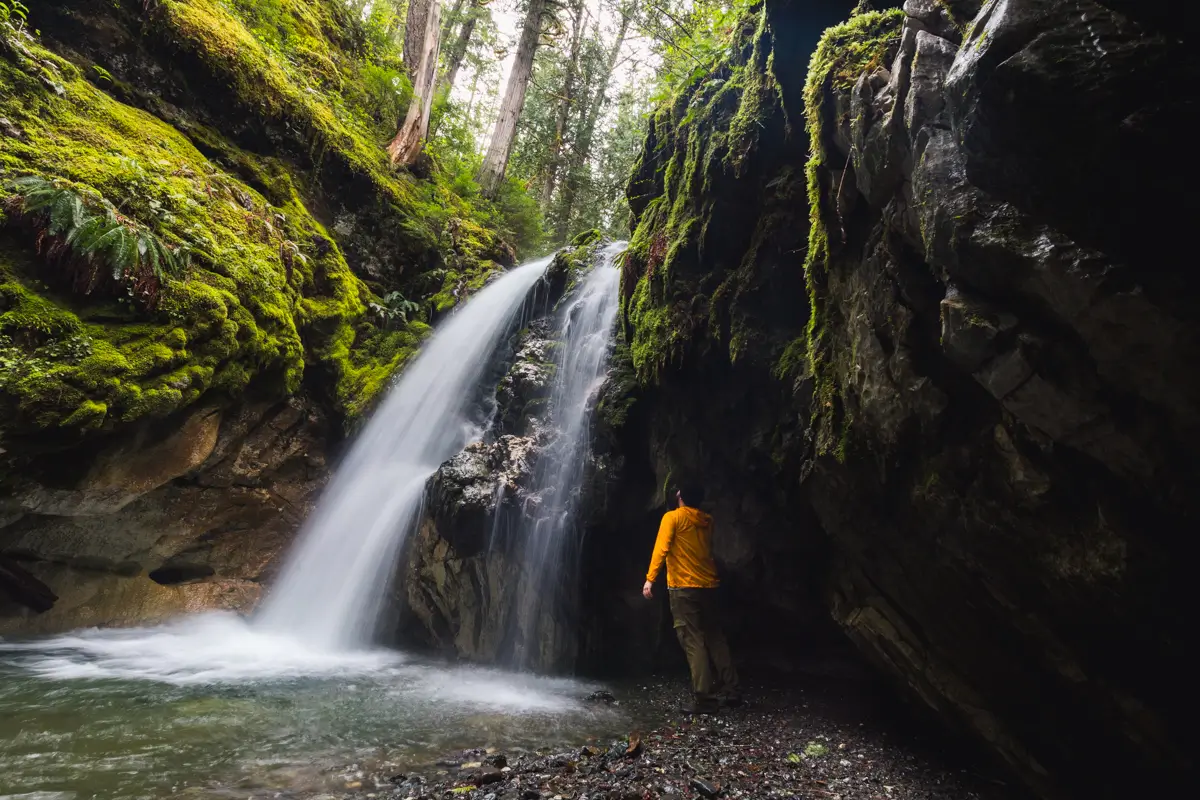
Before visiting Strathcona Provincial Park it’s essential to read up on the BC Parks rules that must be followed to avoid tickets and/or fines. Harmful practices to avoid in Strathcona Provincial Park include disturbing plants or rock-stacking, or removing any natural object from flowers to rocks, as it’s important to leave the environment as natural as possible for the animals and for fellow hikers to enjoy in perpetuity. As many flowers as there are, there are few enough that if we all took one, then there wouldn’t be any left. Take only photos, leave only footprints.
If you haven’t heard of Leave No Trace principles, they’re also really essential to read up on before heading anywhere into the outdoors in general. Following these important principles basically means doing your best to leave beautiful places like Karst Creek Falls as good (if not better) than you found them, both for their preservation and for the enjoyment of other visitors.
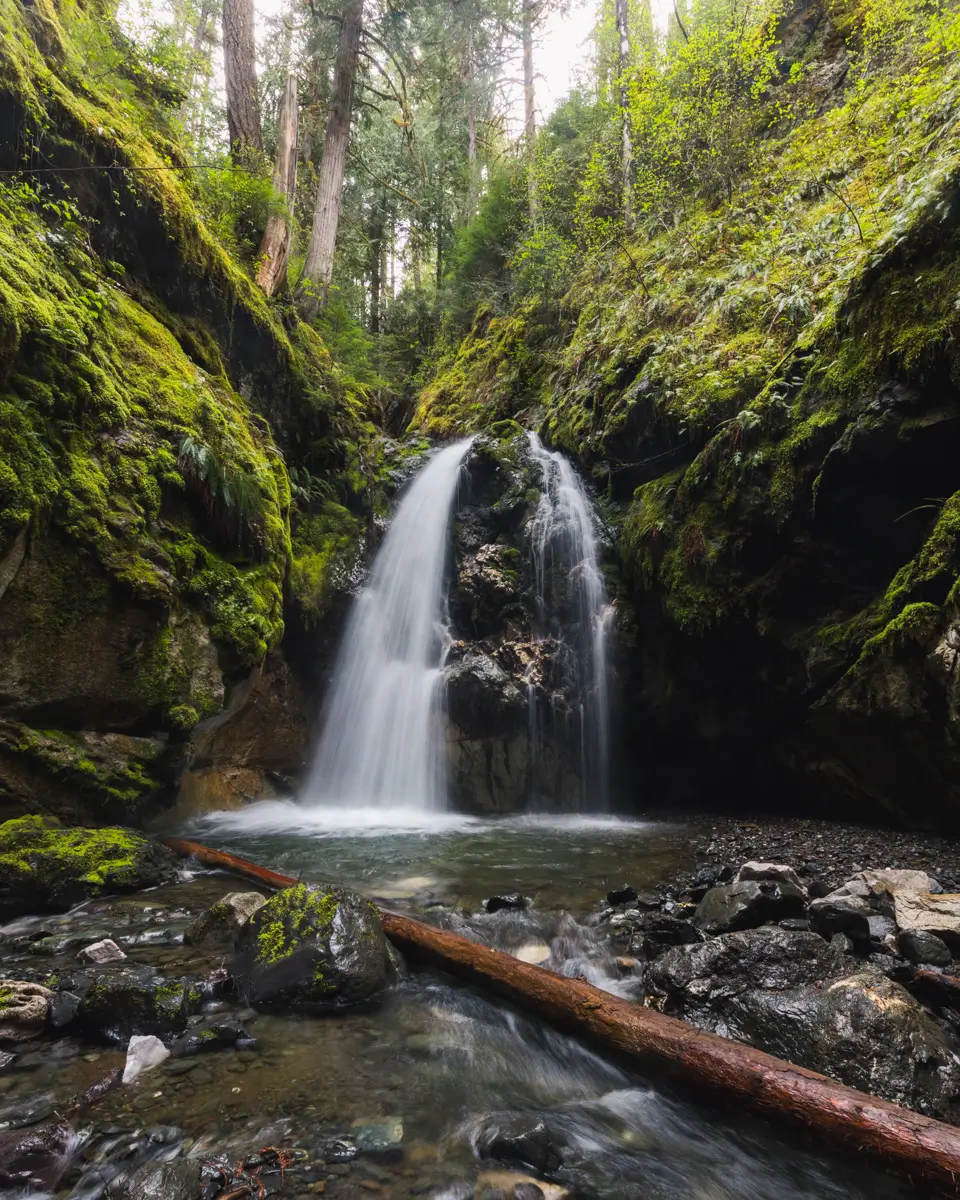
Karst Creek Falls Round Trip Details
Distance: 3.3 KM / 2 MI
Elevation Gain: 62 M / 203 FT
Hiking Time: 30 Mins
Hiking & Safety Tips
- Prepare for the possibility of wildlife encounters. There are almost no grizzly bears on Vancouver Island, but black bears are still common. Bear bells are proven to be an ineffective bear deterrent, and are even actively discouraged by Parks Canada. The best way to let bears know you’re around is simply to use your voice. Make sure to keep a respectful distance from wildlife and never feed the animals. It may seem kind but it doesn’t just kill wildlife and put people in danger, it’s also in many cases illegal.
- Research current trail conditions and make sure you are well-informed about the route before you leave, and assess if it is within your capability. Be aware of what time it gets dark and check the weather forecast. Make sure to tell someone where you’re going and when you expect to return. Every year as more and more people try hiking for the first time, the number of rescues goes up. Being prepared is the best defense.
- Pack everything you need for a successful hike, including enough water and energy-rich snacks. Remember to pack out everything you pack in though – don’t expect to find a convenient garbage can halfway up the trail. Bring appropriate layers (remember you’ll warm up once you start hiking) and sun protection. Hiking poles may be helpful but are not required. In addition to not leaving any garbage on the trail yourself, I highly recommend bringing a garbage bag and collecting any trash that you do see on the trail. You’re guaranteed to make the walk to Karst Creek Falls a more enjoyable experience for the next person.
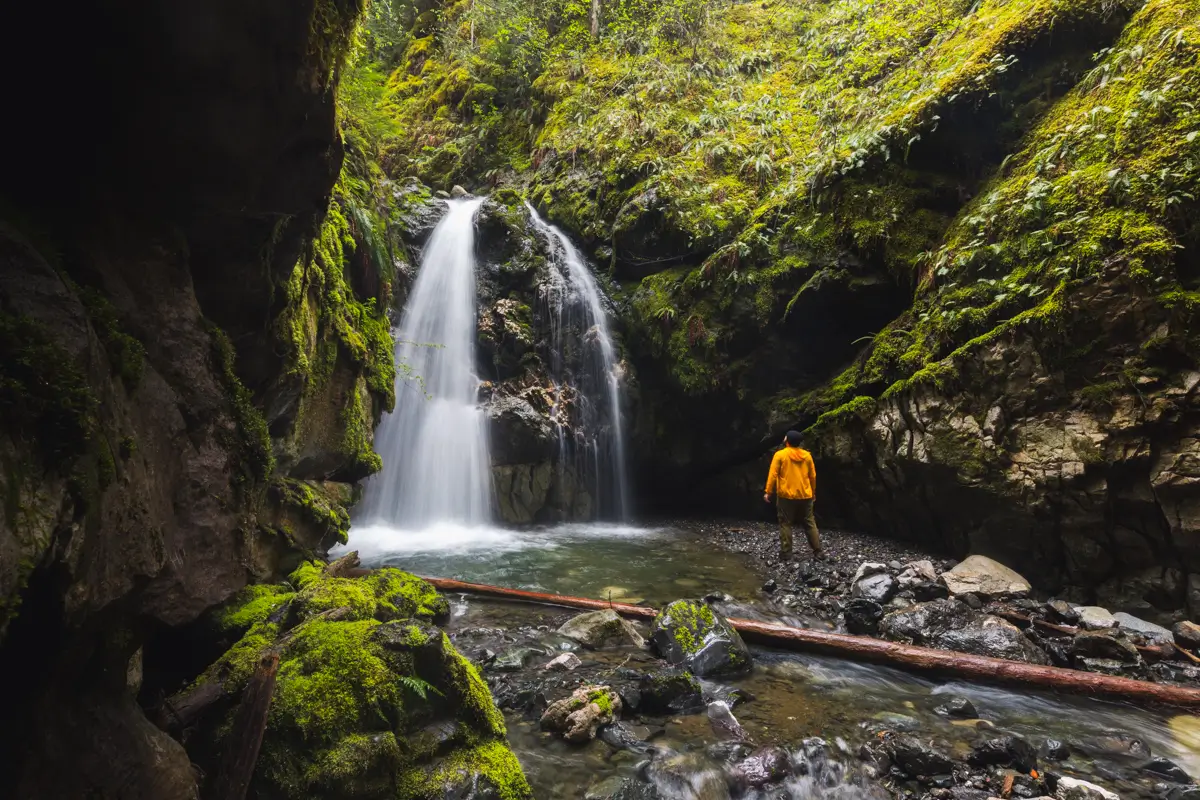
When to Visit Karst Creek Falls
Karst Creek Falls is different from most other Vancouver Island waterfalls in that the best time to visit is not during the rainy months of October to April. During the peak of the rainy season on Vancouver Island, waterfalls can be guaranteed to be fat and gushing with water but often dry up in summer, however due to the creek crossing involved in reaching Karst Creek Falls, it is likely unreachable in winter. Plus, the creek that has to be navigated again at the end of the trail can be challenging even when the earlier crossing is easy. I hiked to Karst Creek falls at the beginning of May, and it was ideal. The waterfall was still flowing beautifully, and crossing the creek was manageable.
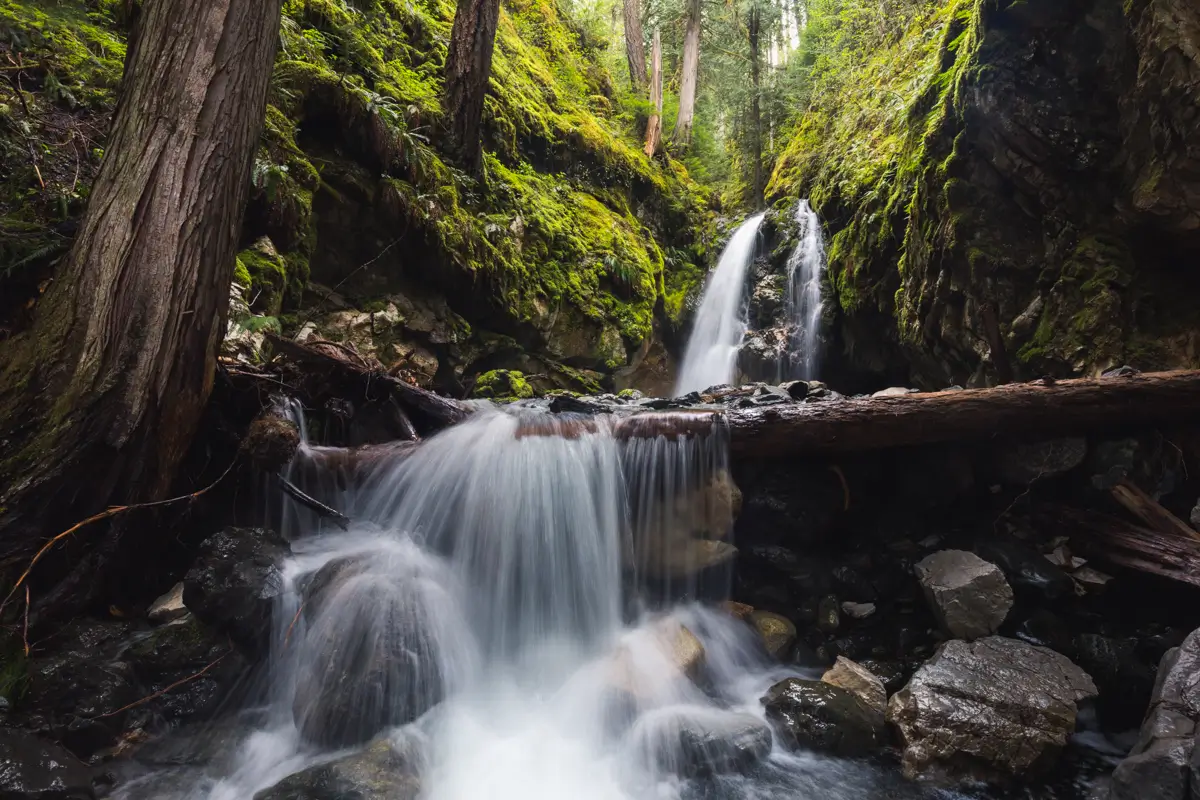
How to Get to Karst Creek Falls Trailhead
Karst Creek Falls is located just off of Buttle Lake in Strathcona Park, or about an hour away from Campbell River. This same road is used to access a couple of other beautiful Strathcona waterfalls, including Lupin Falls and Lower Myra Falls, so it’s very doable to hit all three waterfalls on one trip. From Campbell River, drive West along Campbell River Road, which turns into Gold River Highway soon after leaving town. After about forty minutes, continue straight through the intersection to follow Westmin Road south into Strathcona Provincial Park. Keep an eye out for Buttle Lake on your right. After about five minutes the small parking area signed for Lupin Falls should be clearly visible, and after another fifteen minutes you’ll see the sign for Karst Creek Day Area. Turn into the day area and park. Don’t forget to walk down to the lake from here to check out the views. The trail starts on the opposite side of the road from the turnoff.
Click here to open the exact trailhead location in Google Maps.
Hiking to Karst Creek Falls
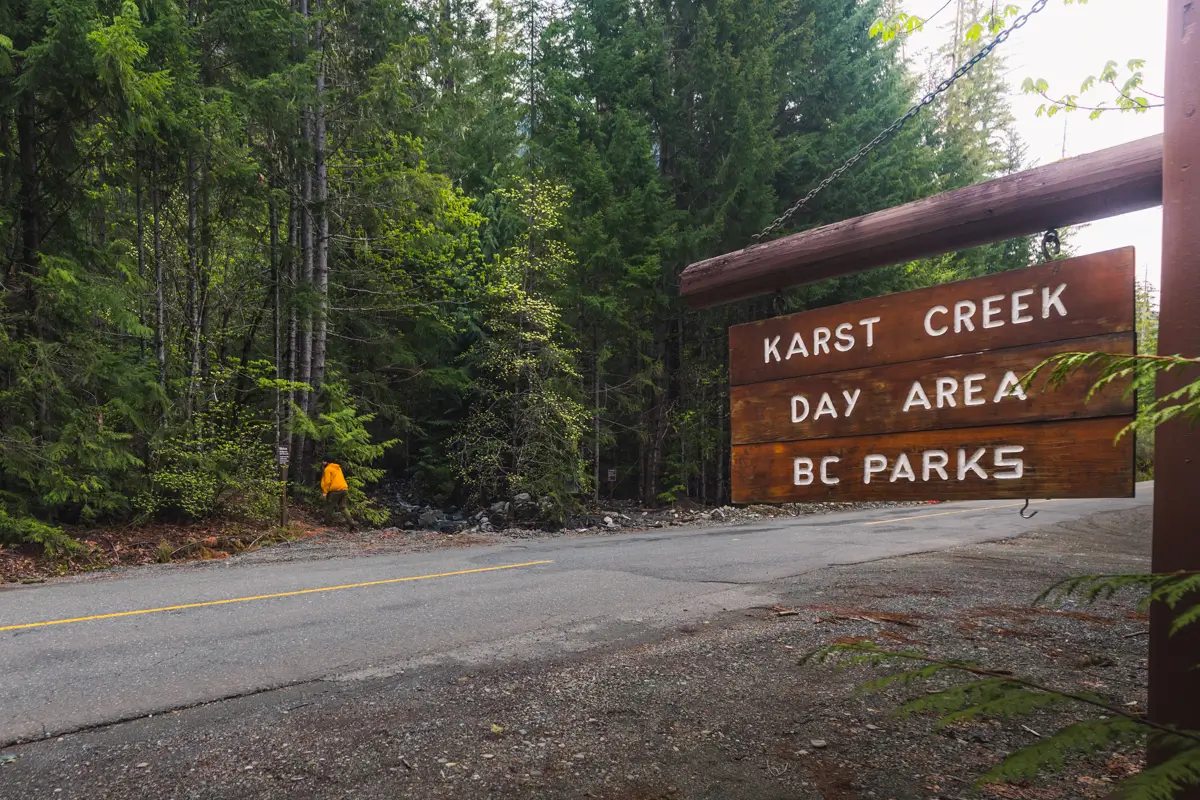
The start of the Karst Creek Trail, across the road from the Karst Creek Day Area.
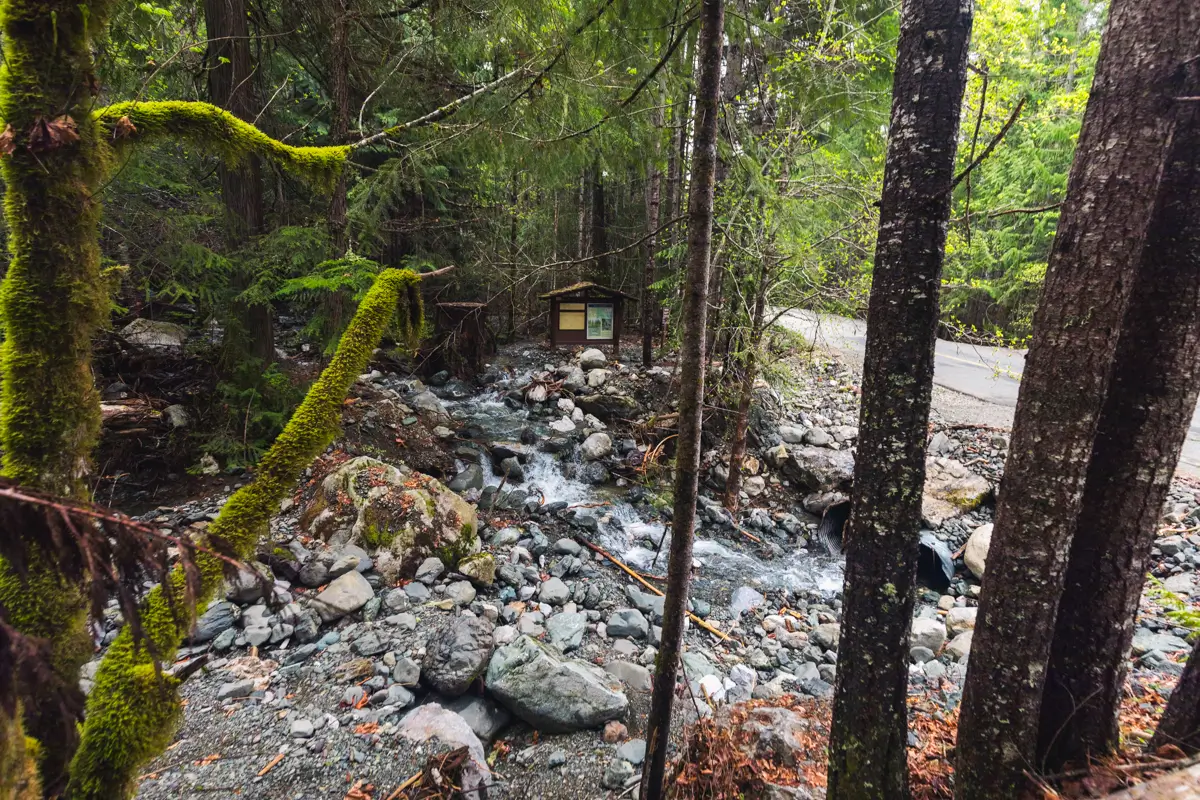
The loop trail starts on the left side of the creek, and exits near the sign visible hereon the right side. In spring the creek washes the trail away, thought it dries up in summer. It wasn’t particularly hard to bushwack along the edge of the creek at the end of trail to avoid getting wet, but I highly suggest assessing the depth of the creek at the start of the hike to decide whether it’s doable to complete the loop.
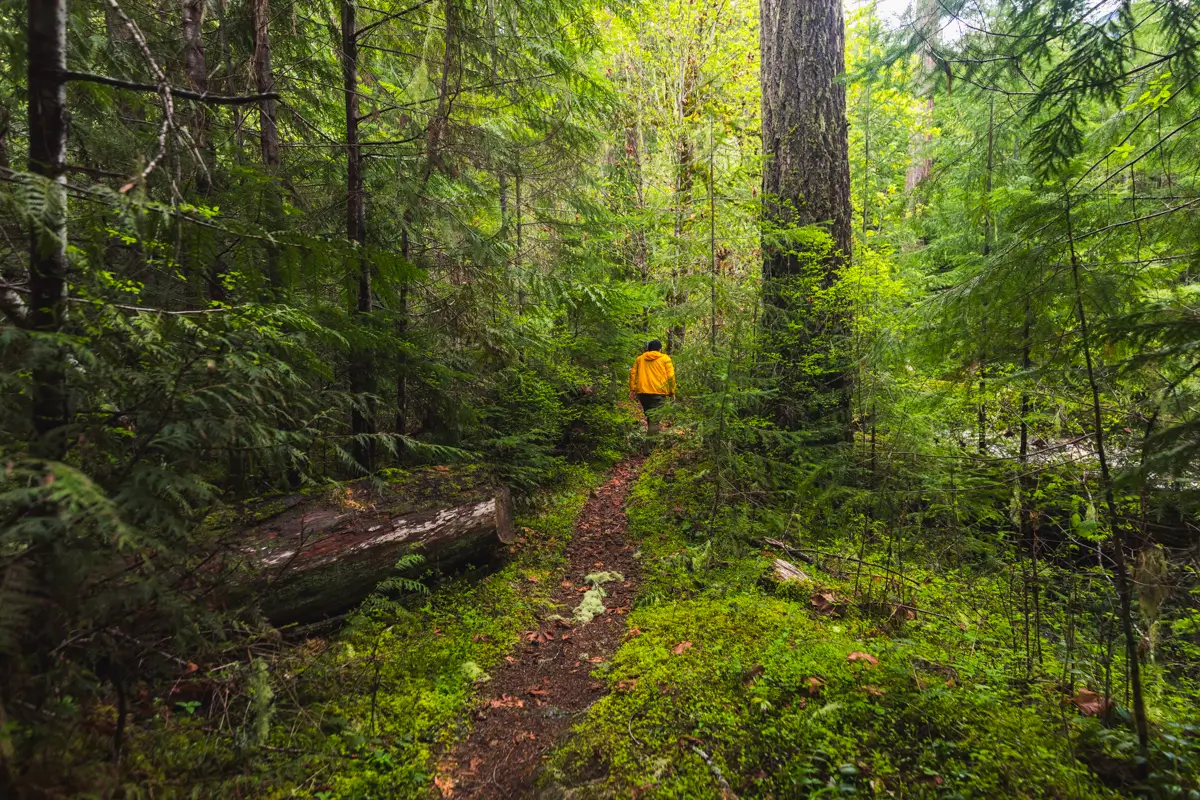
The Karst Creek Trail follows up along the left side of the creek. When I visited the forest was insanely lush and the mossy was anunbelievably bright green full of life.
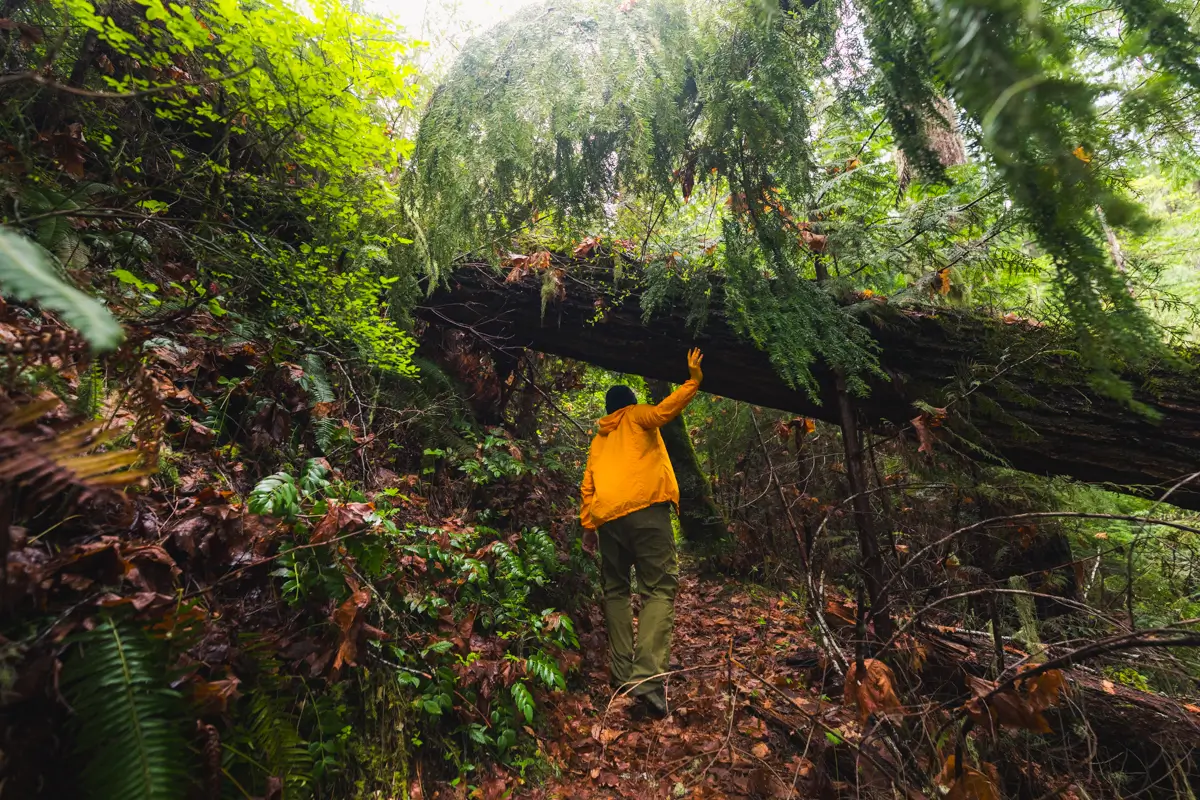
There were a couple logs to walk under on this section of the trail, but nothing that required cirques-du-soleil-level contortion.

These pretty pink flowers were just starting to bloom. If anyone knows what they are I’d love to be able to label them, so please let me know.
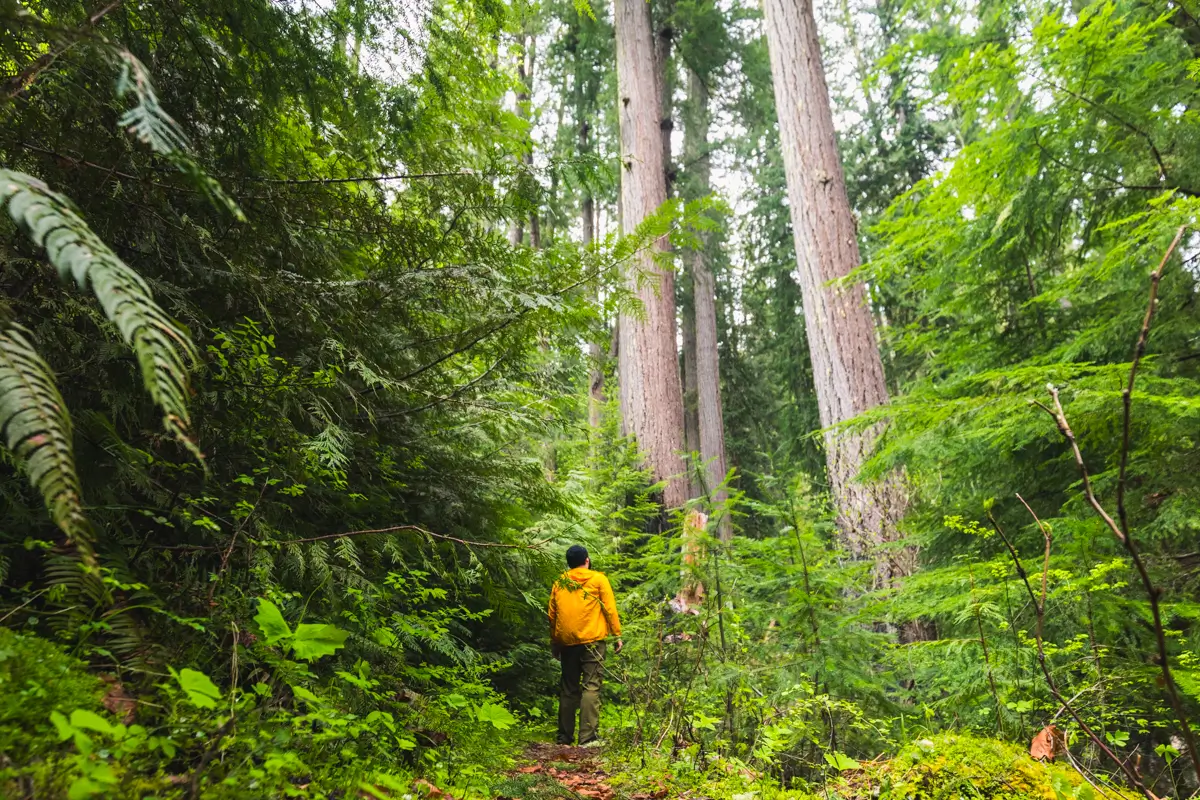
A few tall trees. Interestingly, the bases of these trees are all scarred from some old fire.
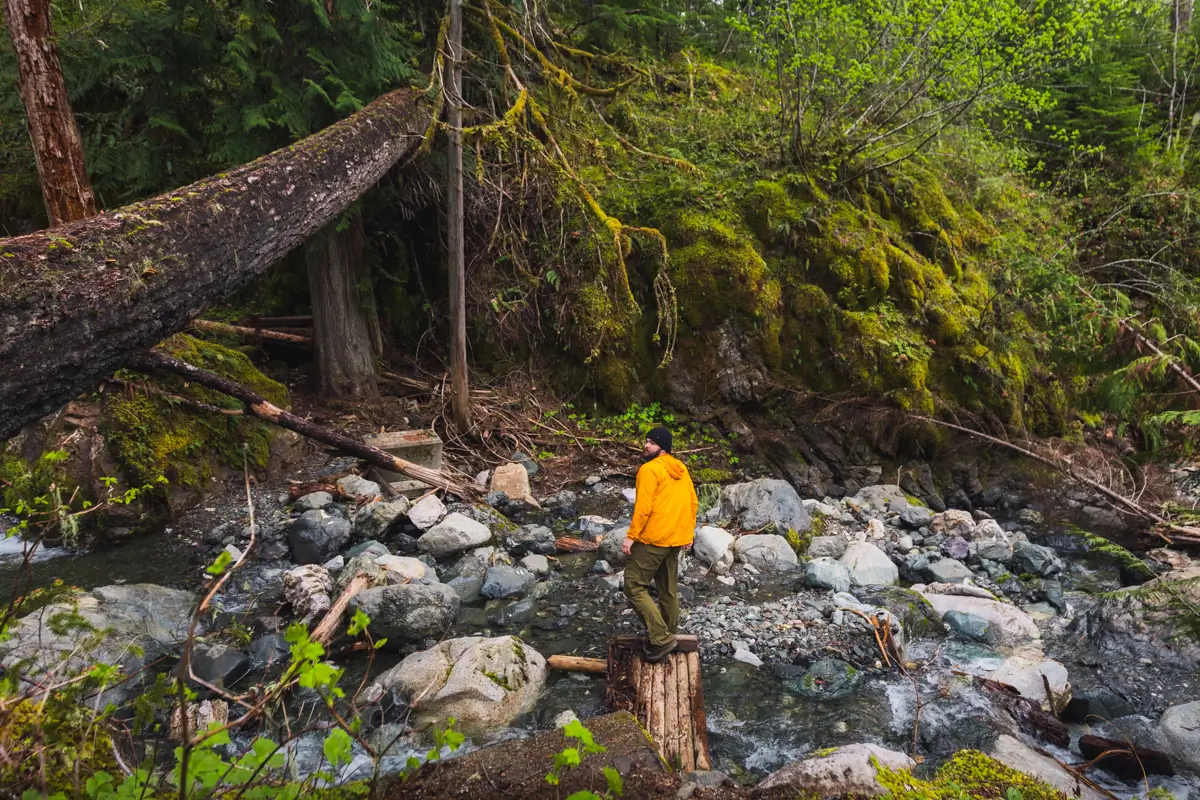
The creek must be crossed. It would have been much easier when there was a proper bridge here, but as it is there wasn’t any problem crossing. If you’re visiting in the winter when the creek is a lot deeper it might be more challenging.
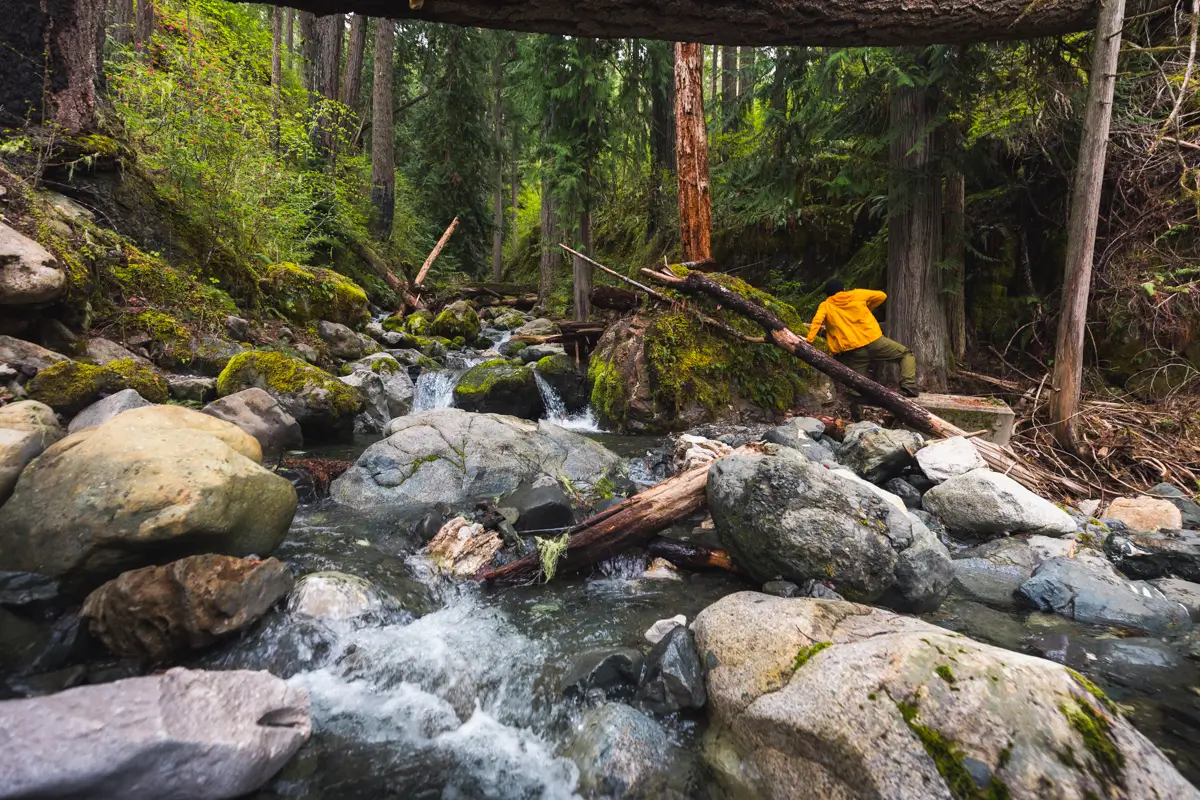
Though it isn’t super obvious from this photo, the trail is easy to pick up on the other side of the creek.
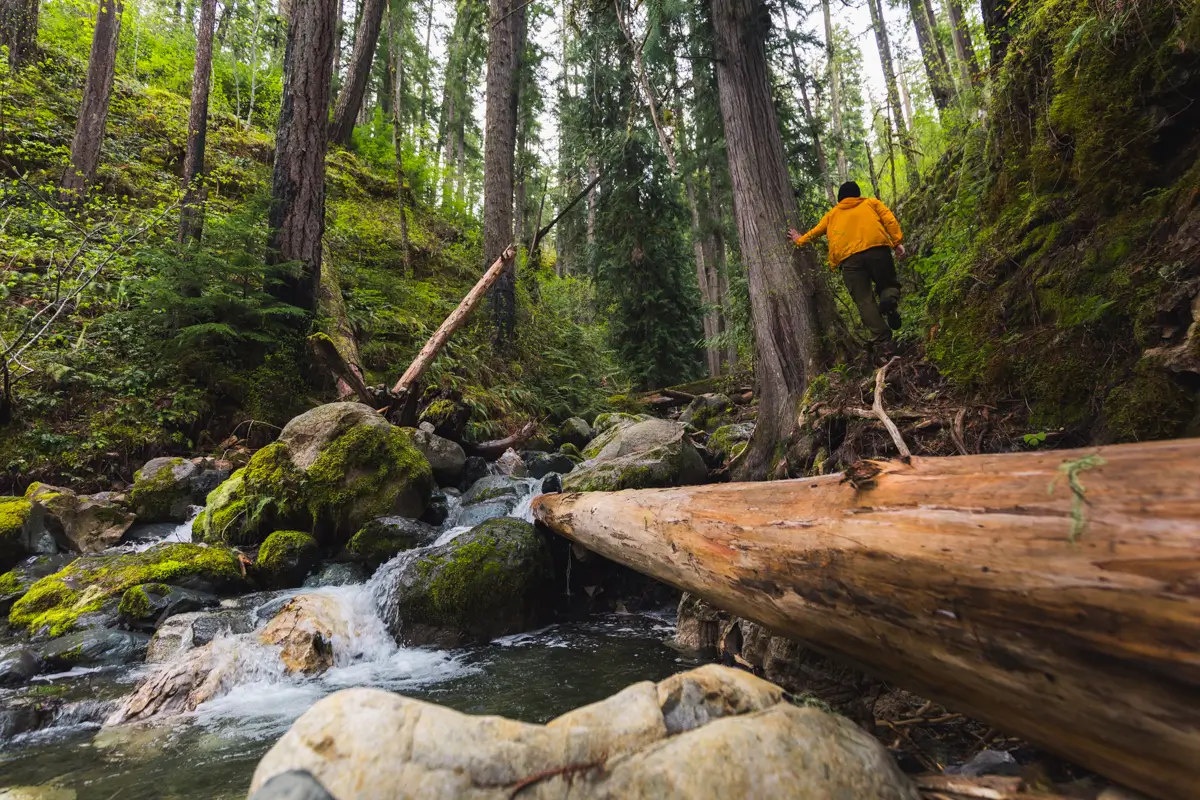
Views into the small canyon Karst Creek flows through are absolutely beautiful. This section of trail here is probably the trickiest if the entire Karst Creek Falls hike, as the narrow trail hugs the side of the cliff closely.
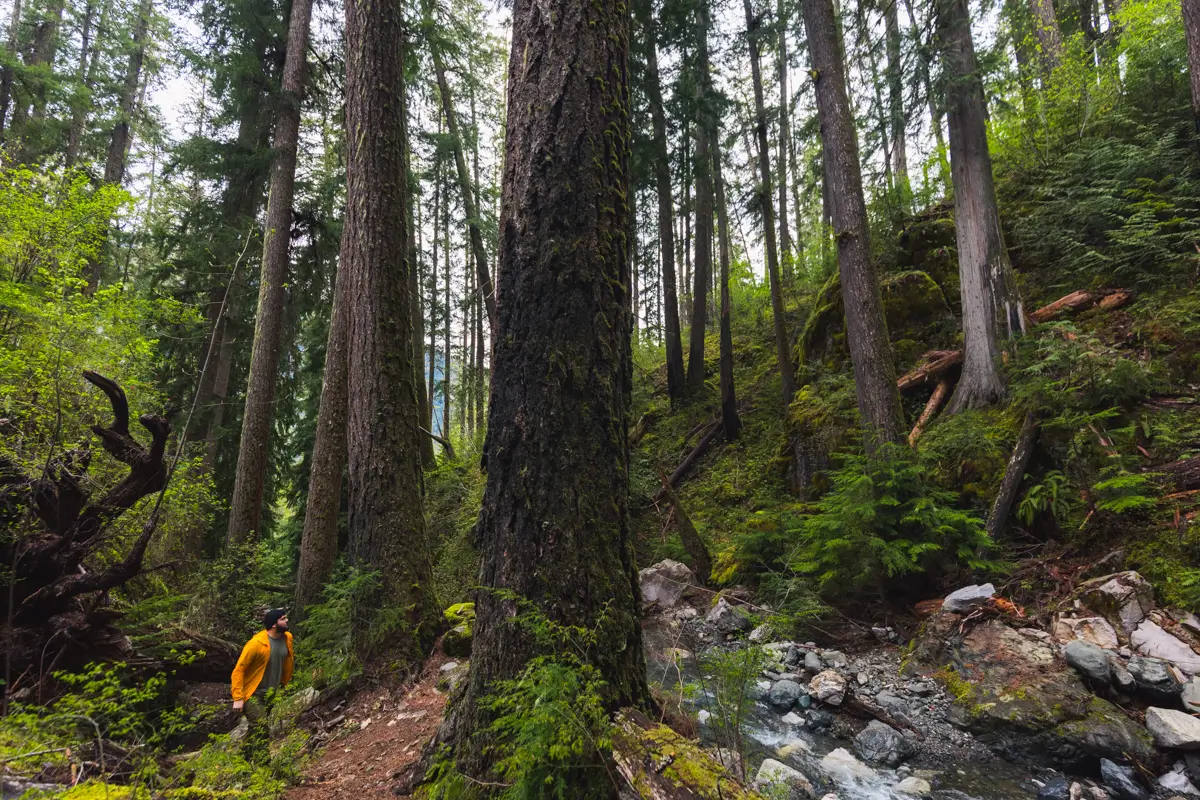
Continuing up alongside Karst Creek.
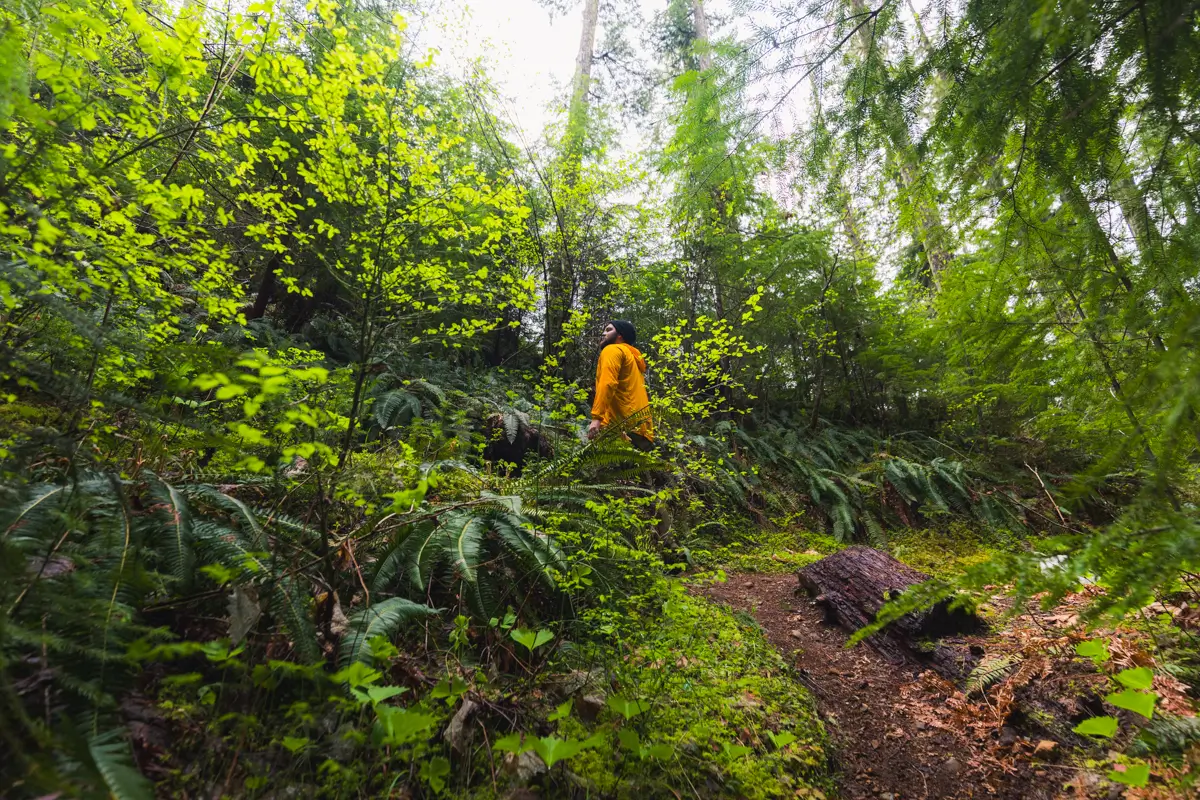
After heading uphill away from the creek a little, the path forks. Turn right to continue along the loop and back towards the trailhead, or turn left to head up to Karst Creek Falls.
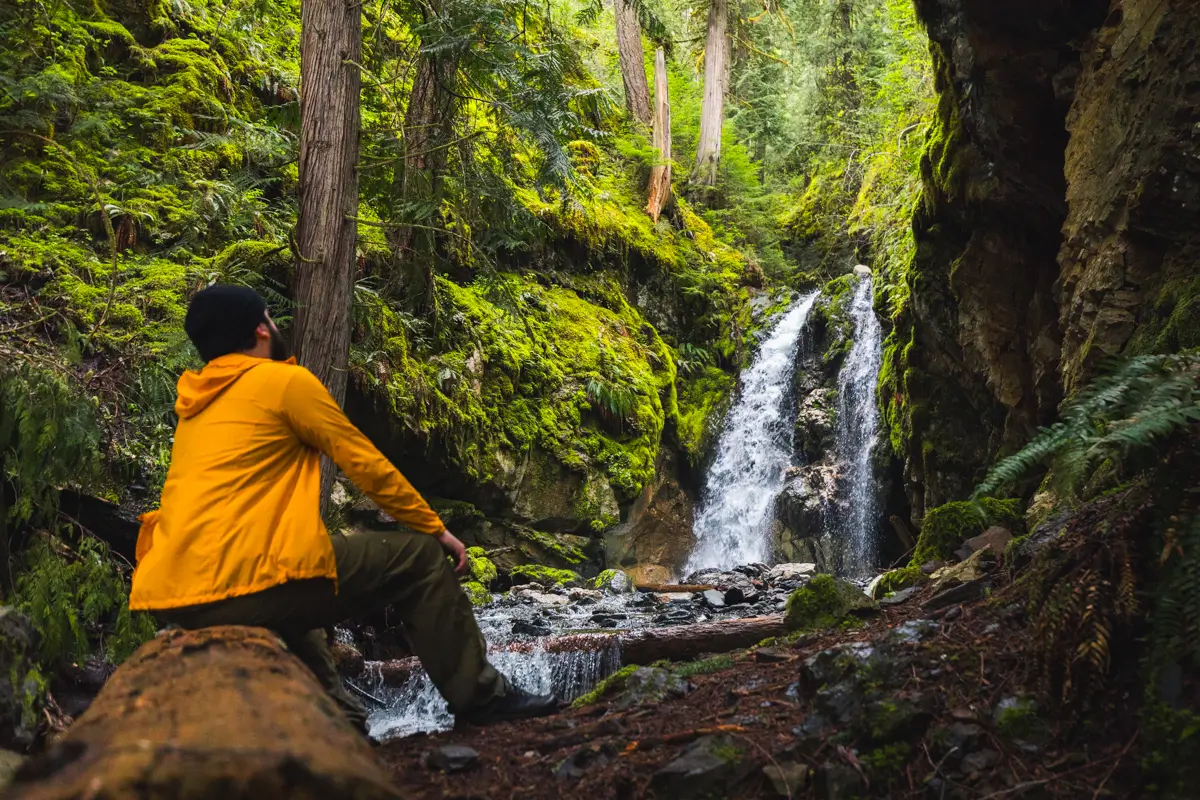
Beautiful Karst Creek Falls. A nearby sign warns of rockfall from above, and I suggest taking it seriously. Google Image search Karst Creek Falls and in almost every photo you’ll see that the rocks at the base of the falls look completely different, suggesting that rockfall happens often. While I did approach the falls to take my photos, I didn’t waste any extra time doing so.
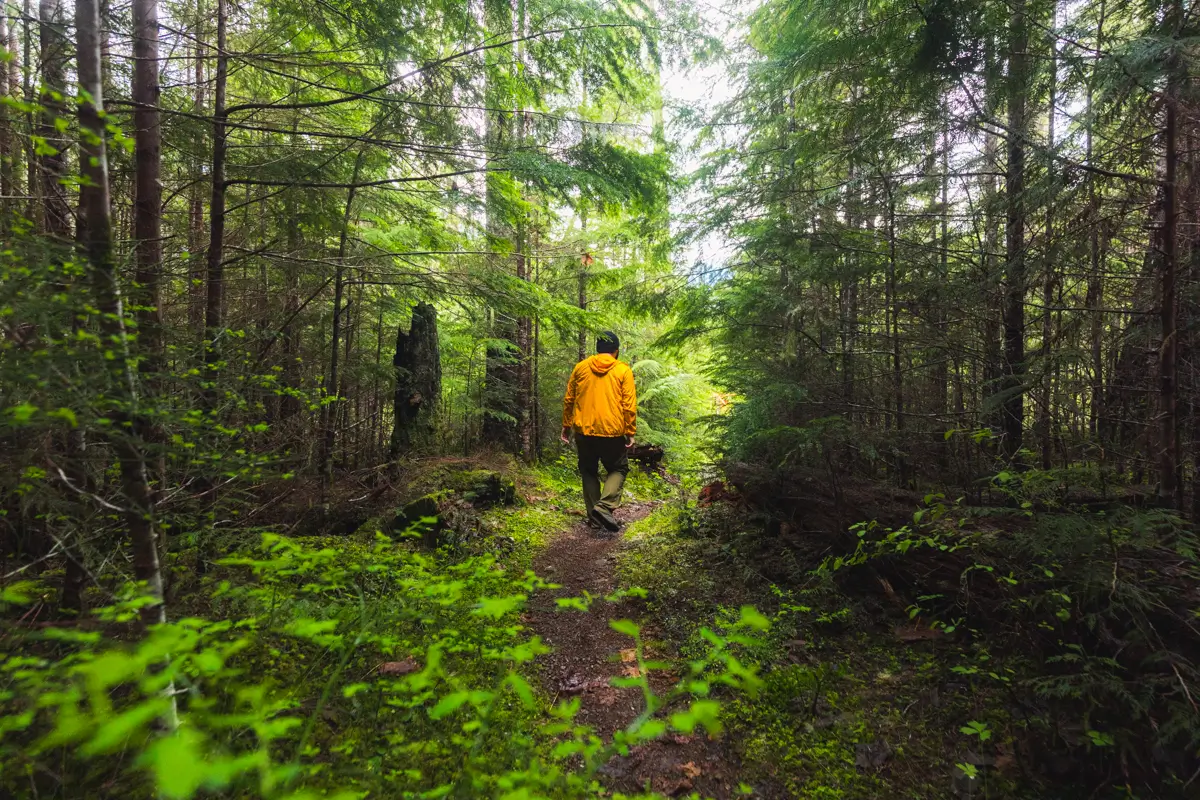
Continuing back along the loop path. Of course it’s possible to just follow the section of trail alongside Karst Creek the way you came, and doing a shorter hike, but I really enjoyed this section of the loop.
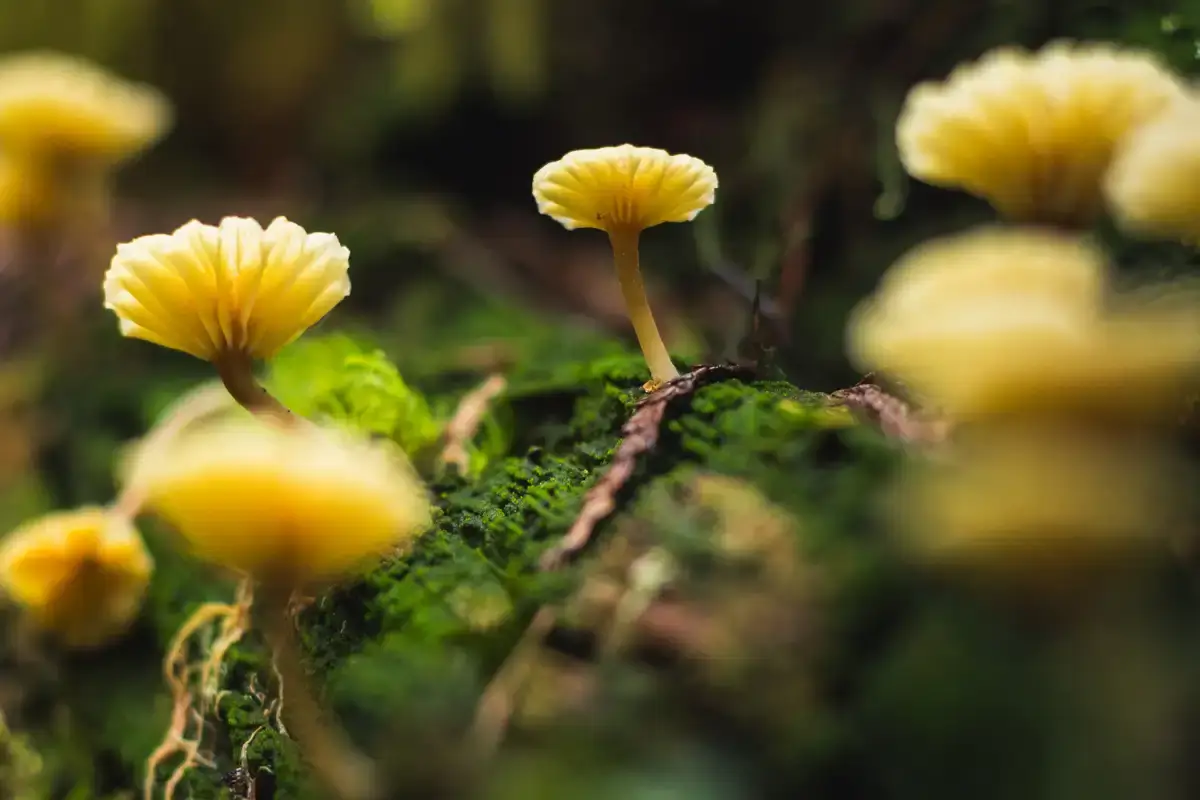
Just a few of of many beautiful mushrooms I noticed along the Karst Creek loop. I’m not a mushroom guy so most of my mushroom photos are unlabelled.
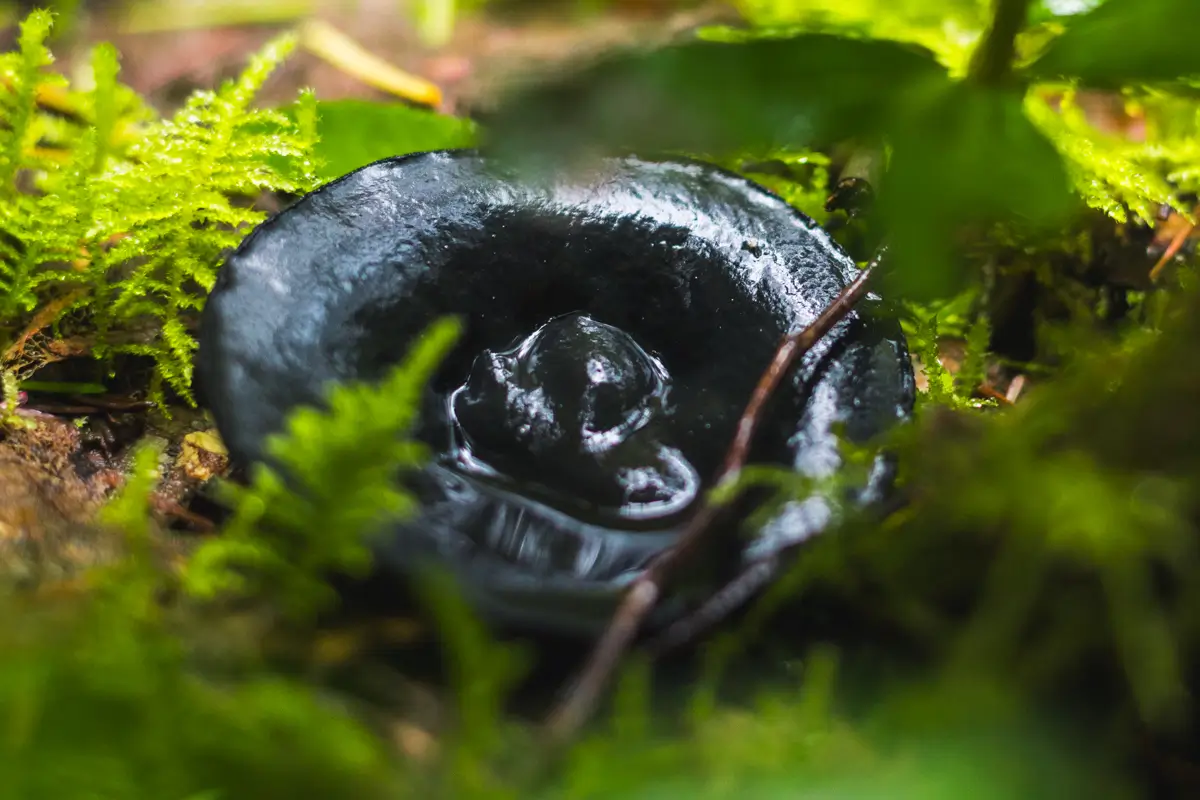
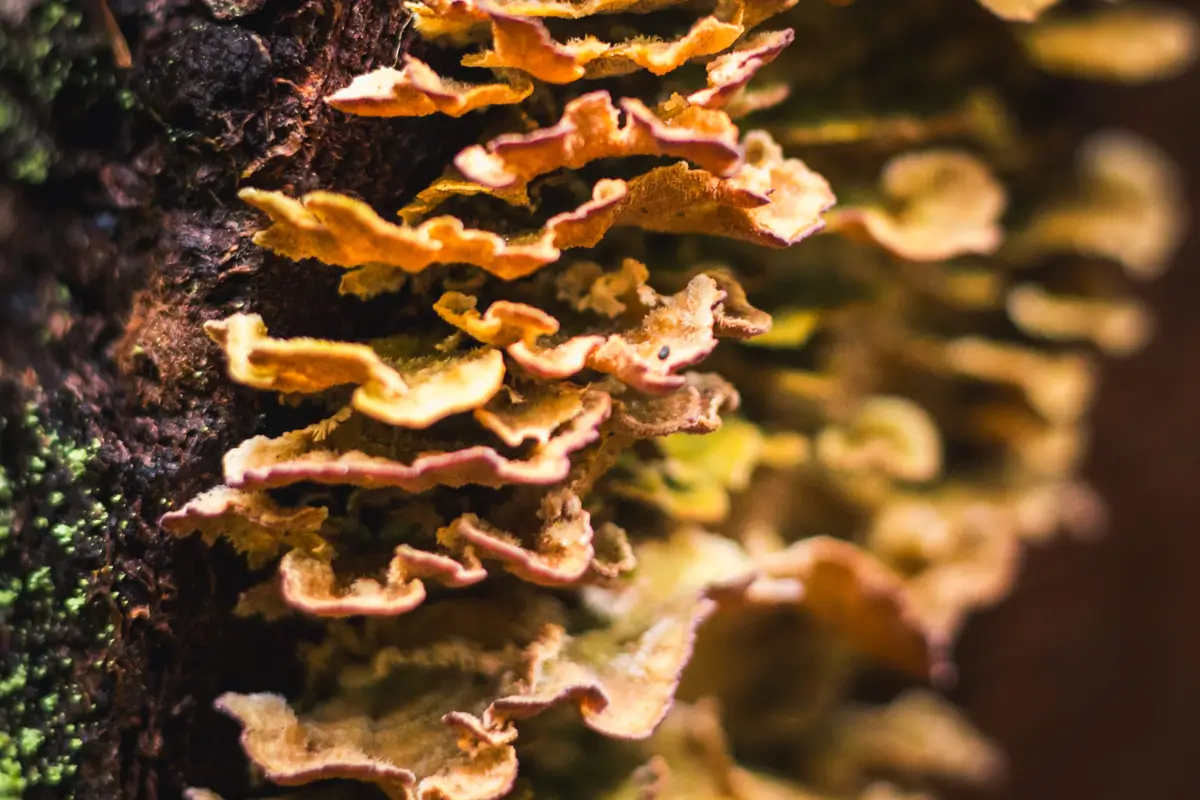
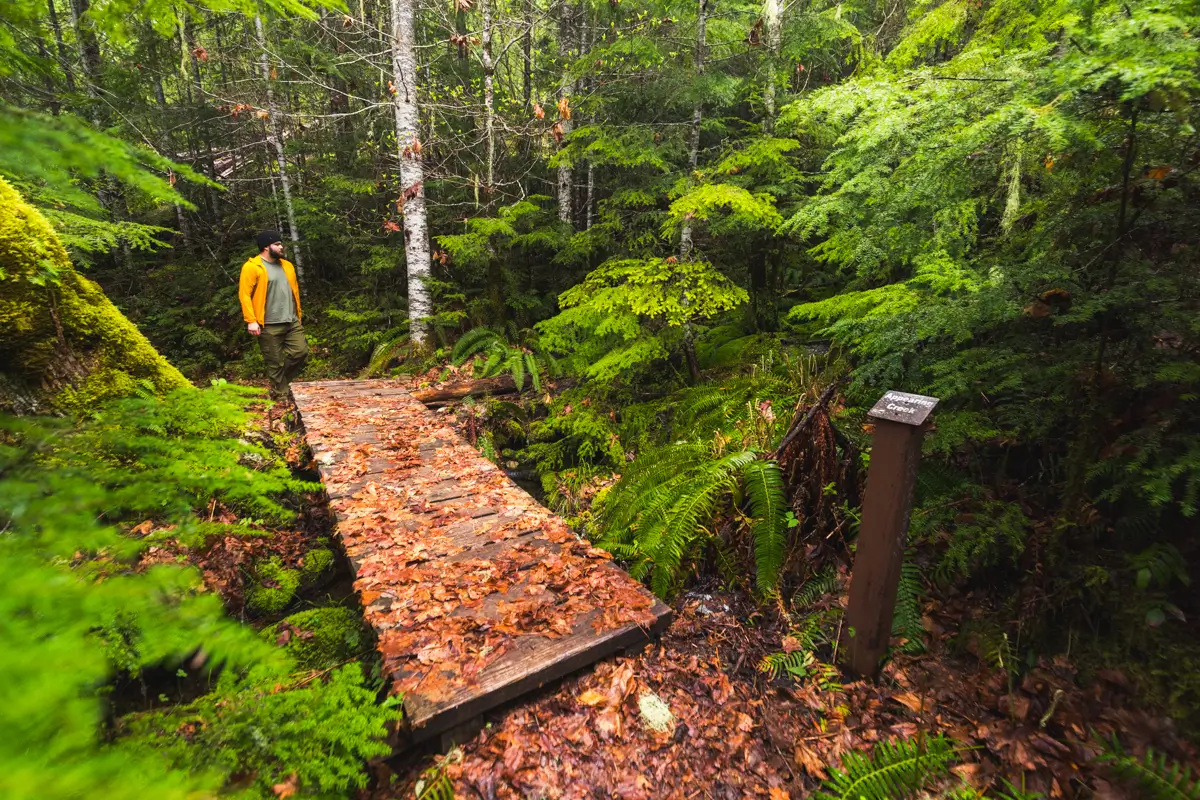
A small bridge and signpost mark Appearing Creek. It’s honestly pretty hard to photograph but it’s pretty cool to see a creek emerge out of the ground.

The trail is easy to follow and fairly flat, but there is some deadfall to be climbed over/around. The trail follows Appearing Creek downstream for a while.
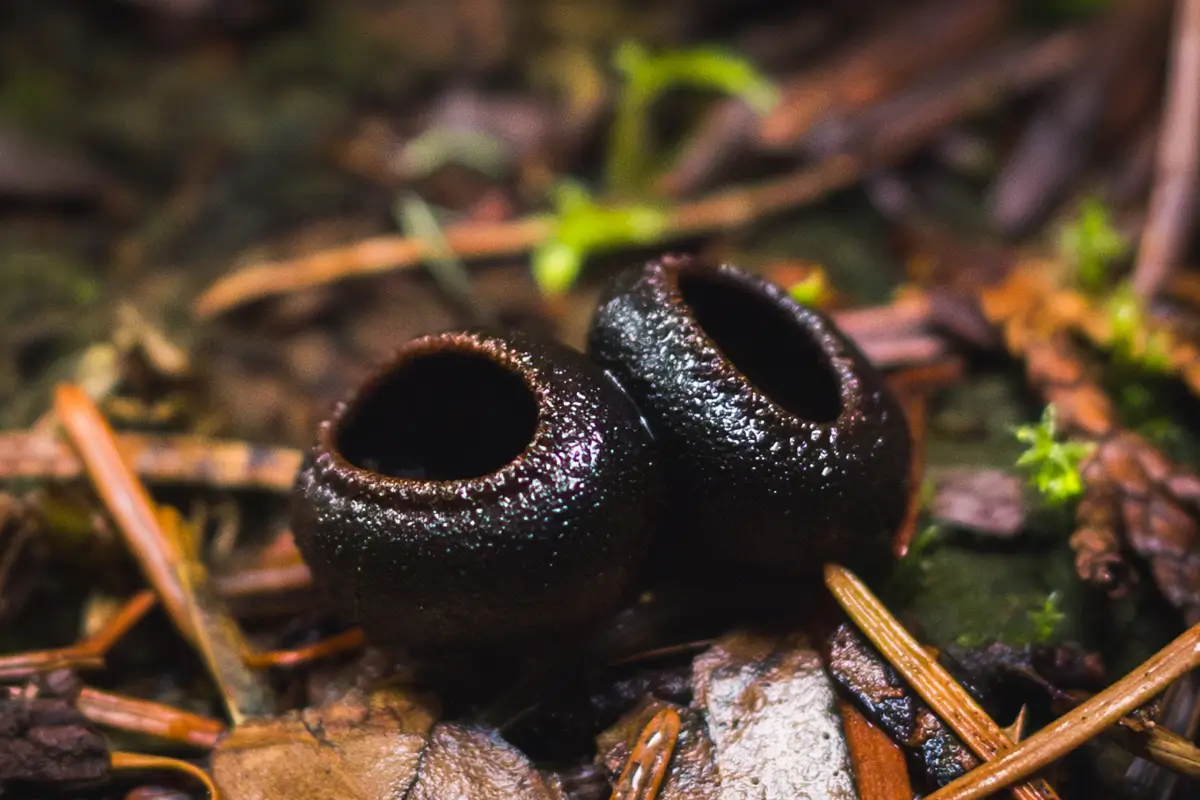
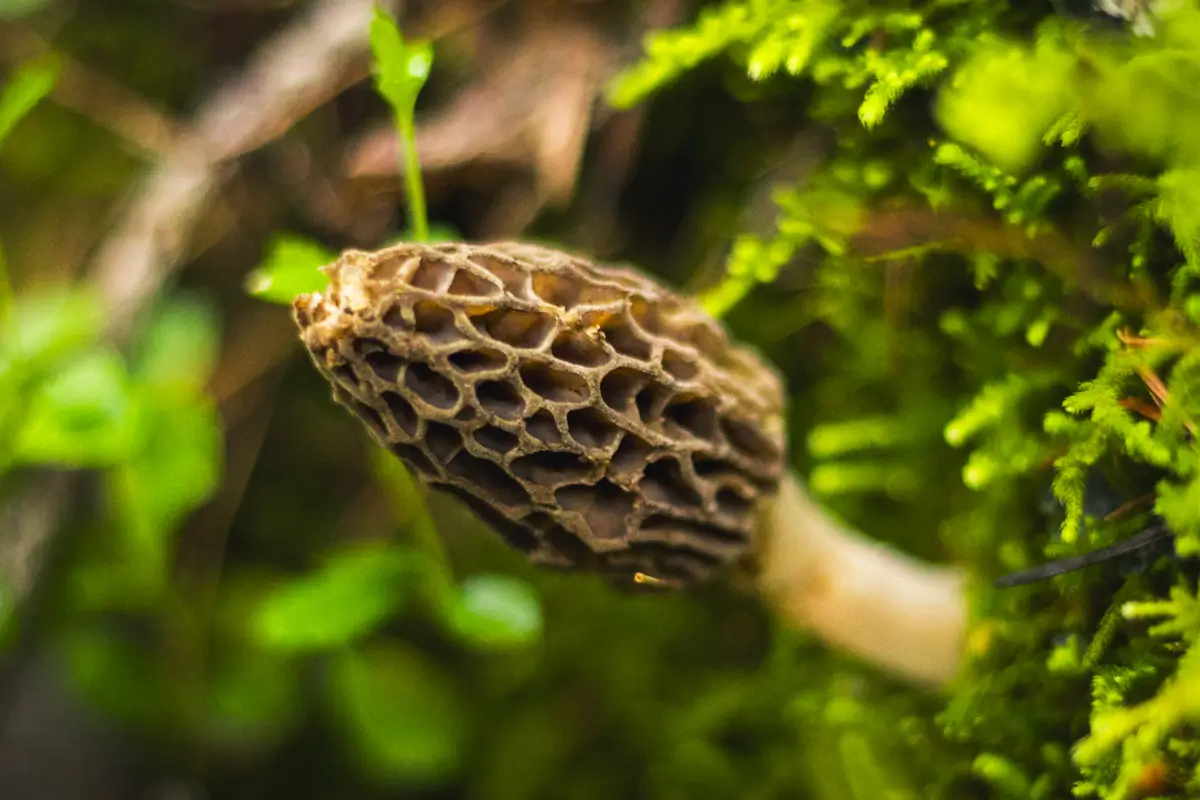
I know this one! It’s a morel. Locals love harvesting them – apparently they’re quite yummy. Of course it’s illegal to remove anything from provincial parks, so this one isn’t up for grabs.
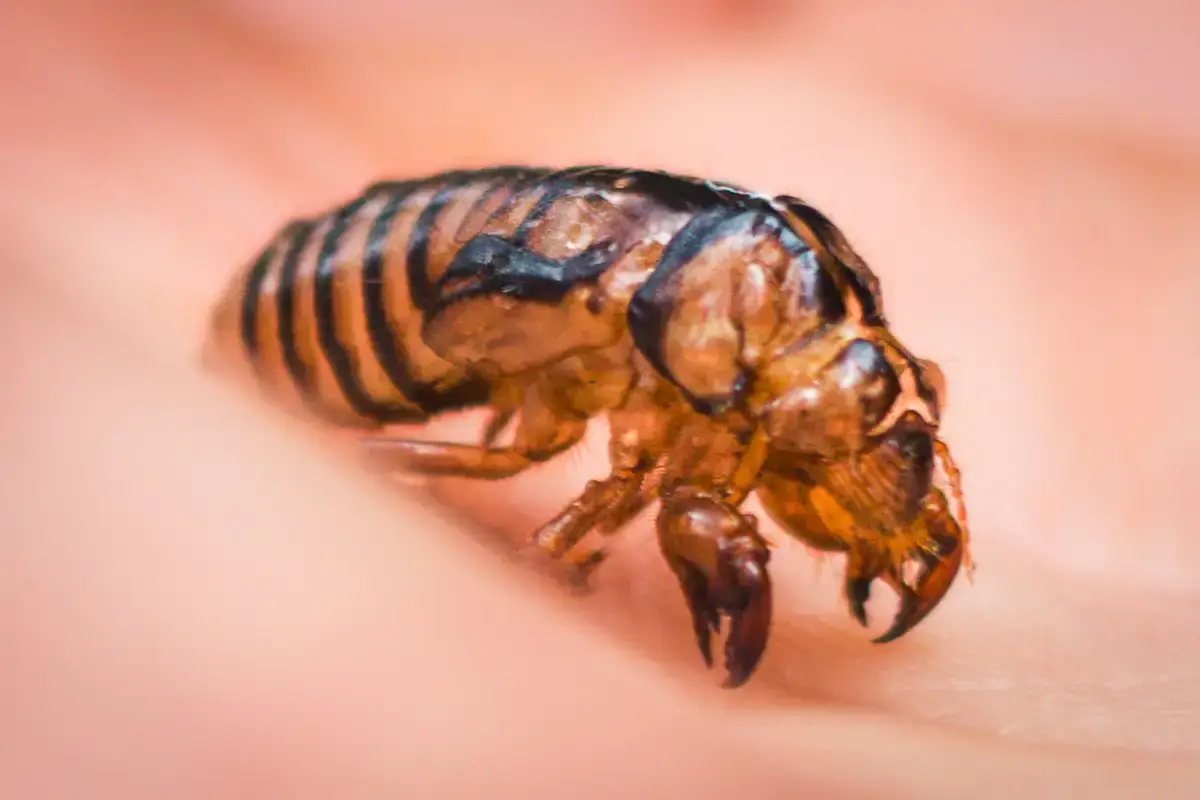
I sat on the ground to take a rest and noticed a couple of cicada molts lying on the trail that I absolutely wouldn’t have noticed otherwise. There’s a lot to be said for slowing down and noticing the details.
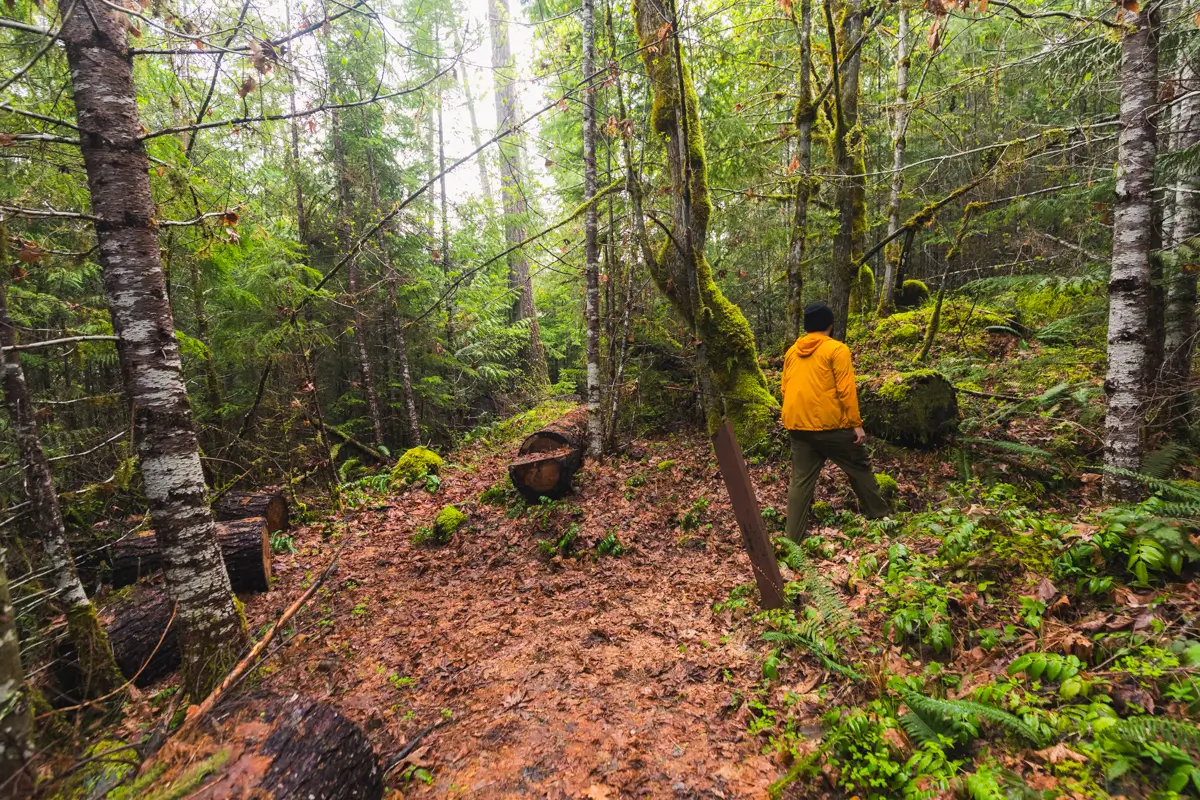
Another sign, and a short detour from the trail leads to Disappearing Creek, where the aforementioned creek disappears into a sinkhole in the ground. Also hard to photograph, but kind of cool to see.
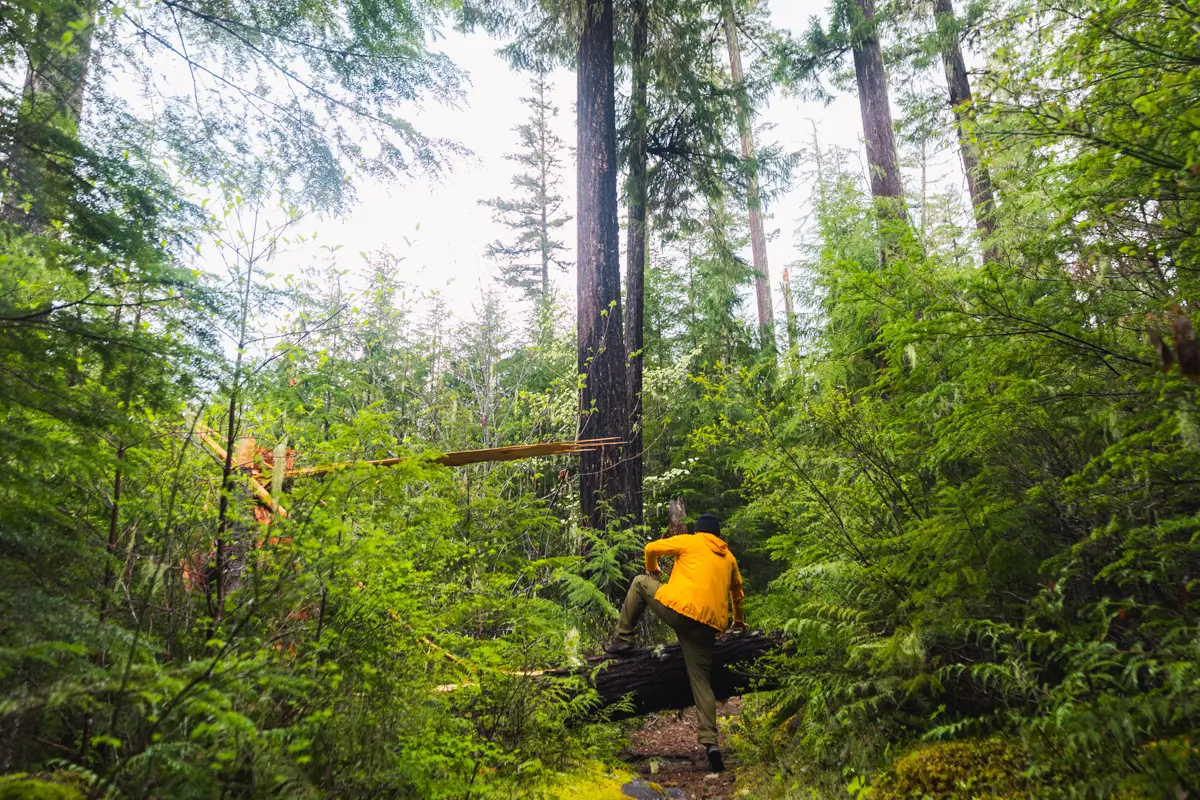
More deadfall.
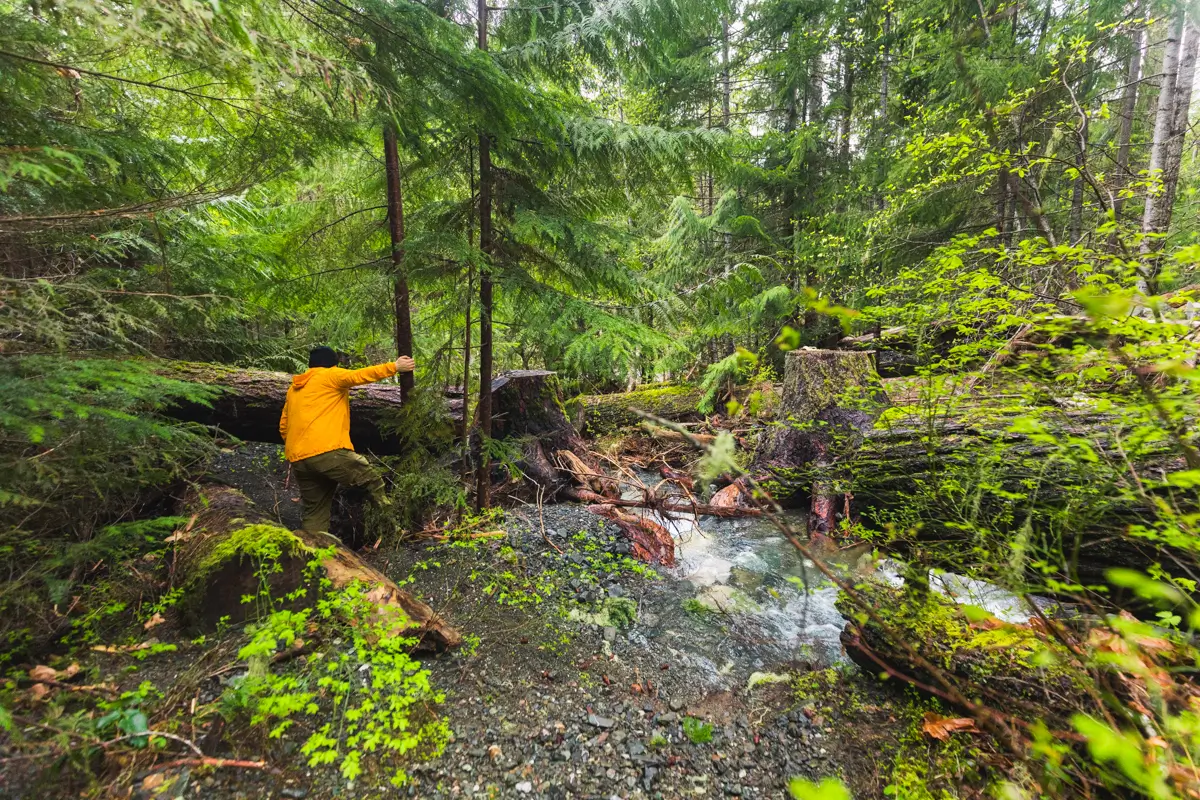
The “exit” of the trail. The road is visible through the trees at the center of this photo, but the rushing Karst Creek has to be navigated alongside.
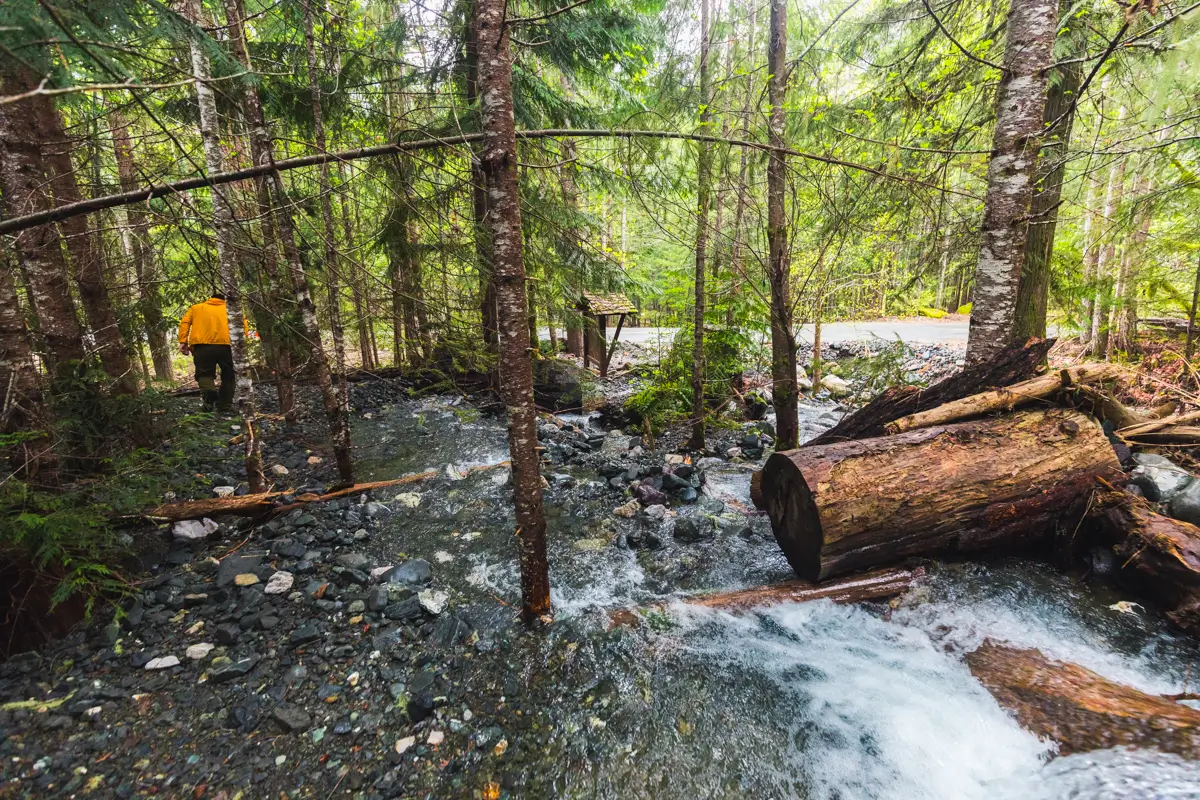
It’s not too hard, but if the water were deeper it might have been more of a challenge, so I suggest assessing at the start of your hike whether you should do the entire loop or not.
Recommended Hiking Gear



Water is a must whenever I’m hiking, especially if the sun is going to be out. My favourite water filter I’ve used is the Katadyn BeFree 0.6L, which unlike other water filters I’ve used packs up really small and lightweight. For hikes where I know there won’t be any readily available water sources along the way, I make sure to bring my own. The Hydrapak Stow 1L bottle is my go-to, for the same reason that it’s made of a soft plastic that folds up and doesn’t take up any more extra space than necessary in my pack. Finally, Aquatabs are another great option for purifying water, with one tablet being suitable for one litre of water. I previously used the Grayl water filter while travelling internationally, and though I found its hard body more convenient for day to day use and easier to drink from, it has a little too much bulk for my fast-and-light style of hiking.



The secret to all my photos of gorgeous sunset and sunrise mountaintop views? A lot of hiking in the dark. And let me speak from personal experience when I say that the last thing that you want to happen when hiking is to be caught in the dark without a headlamp. I used the Black Diamond Spot 400 for years and it worked great – until I lost it on top of a mountain somewhere. The only downside to it was having to worry about the batteries dying, though there’s also a slightly more expensive version that has a rechargeable battery. Nowadays I’m using the Petzl Actik Core, which is a bit pricier than the more budget-friendly Black Diamond, but is also brighter, more comfortable (in my opinion), and has a hybrid power system that is rechargeable but can also take AAA batteries if needed.
You won’t see me using trekking poles on shorter hikes often – but on long hikes and backpacking trips, as well as certain scrambles, they are an absolute lifesaver. I’ve invested in a high quality ultra-lightweight pair of MSR DynaLock Ascent carbon poles which, while pricey, I don’t regret one bit. If you’re not entirely sure how much use you’re going to get out of a pair of trekking poles, the best budget-friendly option would be the Trekology Trek Z 2.0. Amazon does sell a lot of cheaper Made in China-style trekking poles for cheaper, but these usually are much much heavier and not worth buying.
All the best and most long-lasting cables and power banks I’ve ever owned have been Anker. I once had a phone cable from them that lasted me over three years of daily use! That’s why I keep an Anker PowerCore Essential 20K power bank on me. Like many people I use my phone for a lot of stuff when hiking (checking in with family, using online maps, taking photos, flying my drone) so I like to be prepared for that low battery warning by having a backup power source on me just in case.



The only socks I ever buy for myself are from Darn Tough, and I almost always make sure to wear them when hiking. After years of having no problems only wearing these comfortable and rugged socks for hikes, I accidentally wore a pair of no-name socks on a hike last year and ended up with blisters on both feet. Safe to say I’m back to sticking with the Darn Tough. And the best part? They have a lifetime guarantee, meaning that if they ever wear out you can send them back for a brand new pair. For hiking footwear I go between a pair of lightweight approach shoes for quick and dirty mountain ascents or anything involving scrambling and more heavy-duty boots for longer treks. I’ve worn a couple different versions of the lightweight but super durable Arc’teryx Konseal FL 2 approach shoes for a few years now and am very impressed with the durability. I also really like the thick toecap that keeps me protected every time I stumble into a root or large rock. For longer, tougher, or muddier treks I rely on my LOWA Camino EVO GTX, which I find insanely comfortable and made of very high quality.



I wear my Ar’teryx Gamma Lightweight Pants on every single hike I go on, and on many days when I’m not hiking. After several years of abuse they are still holding together extraordinarily well, with only a few small holes from where I’ve fallen down and some slight stains from being repeatedly coated with mud. They’re lightweight, breathable, and super comfortable. For lightweight and breathable hiking tops I’m a big fan of both the Patagonia Capilene Shirt and the MEC Core Shirt. My Arc’teryx Squamish Hoody shows up in a lot of my photos. It’s super lightweight and packable, and does a great job of cutting the wind while also being pretty breathable. I also have an Arc’teryx Atom Hoody and Arc’teryx Beta LT that I pull out for cooler or wetter conditions.
I hope you enjoyed this guide to hiking to Karst Creek Falls in Strathcona Provincial Park! Feel free to leave any questions in the comment section below or to contact me directly via social media.
